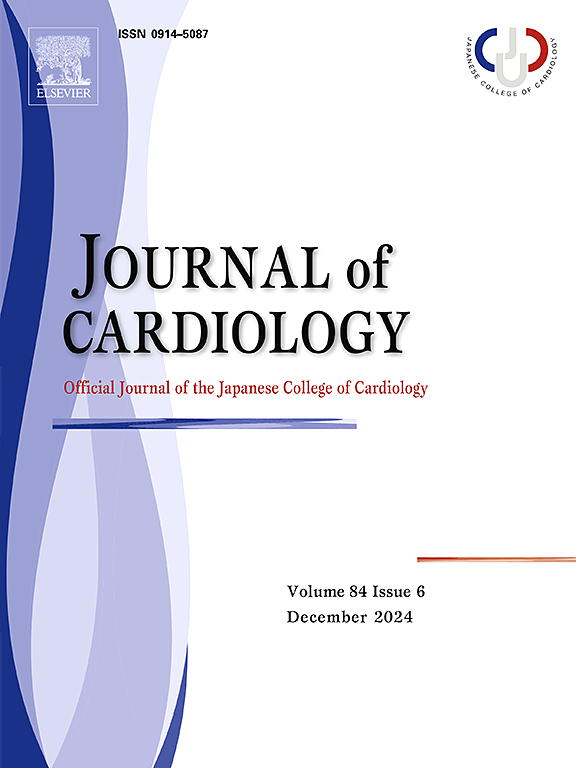The efficacy of inspiratory muscle training in improving clinical outcomes in heart failure patients: An updated systematic review and meta-analysis
IF 2.5
3区 医学
Q2 CARDIAC & CARDIOVASCULAR SYSTEMS
引用次数: 0
Abstract
Background
Inspiratory muscle training (IMT) has shown improvements in clinical variables for heart failure (HF) patients. We conducted a meta-analysis to investigate if IMT can enhance respiratory muscle strength, quality of life (QoL), and reduce cardiac biomarker levels in HF patients.
Methods
PubMed, Cochrane Library, and Google Scholar databases were systematically searched up to July 8, 2024. Randomized controlled trials of IMT in HF patients were included. A random effects model was used to calculate weighted mean differences (WMDs) and 95 % confidence intervals. Outcomes analyzed included minute ventilation to carbon dioxide output slope (VE/VCO2), QoL, six-minute walk distance (6MWD), maximum expiratory pressure, maximum inspiratory pressure (MIP), N-terminal pro B-type natriuretic peptide (NT-pro-BNP), forced vital capacity, forced expiratory volume in one second, and metabolic equivalents.
Results
Seventeen studies involving 510 patients (252 in IMT group, 258 in control) were included. IMT significantly improved 6MWD [WMD: 72.72; 95 % CI: (16.65 to 128.78); p = 0.01], QoL [WMD: -15.27; 95 % CI: (−21.01 to −9.53); p < 0.00001], VE/VCO2 [WMD: -5.09; 95 % CI: (−7.36 to −2.83); p < 0.0001], MIP [WMD: 13.77; 95 % CI: (7.51 to 20.03); p < 0.0001], and NT-pro-BNP levels [WMD: -659.66; 95 % CI: (−1212.87 to −106.46); p = 0.02].
Conclusion
IMT significantly improved respiratory muscle strength, QoL, and reduced cardiac biomarker levels in patients with both heart failure with preserved ejection fraction and heart failure with reduced ejection fraction. These findings suggest that IMT may be a promising exercise-based strategy for treating HF.
吸气肌训练改善心力衰竭患者临床结局的疗效:一项最新的系统综述和荟萃分析。
背景:吸气肌训练(IMT)已显示出心力衰竭(HF)患者临床变量的改善。我们进行了一项荟萃分析,以调查IMT是否可以增强心衰患者的呼吸肌力量、生活质量(QoL)并降低心脏生物标志物水平。方法:系统检索截至2024年7月8日的PubMed、Cochrane Library和谷歌Scholar数据库。纳入了HF患者IMT的随机对照试验。采用随机效应模型计算加权平均差(wmd)和95% %置信区间。结果分析包括分钟通气与二氧化碳输出斜率(VE/VCO2)、生活质量、6分钟步行距离(6MWD)、最大呼气压、最大吸气压(MIP)、n端前b型利钠肽(NT-pro-BNP)、用力肺活量、一秒内用力呼气量和代谢当量。结果:纳入17项研究,涉及510例患者(IMT组252例,对照组258例)。IMT显著改善了6MWD [WMD: 72.72;95 % CI: (16.65 ~ 128.78);p = 0.01],QoL [WMD: -15.27;95 % CI: (-21.01 ~ -9.53);p 结论:IMT可显著改善射血分数保留型心衰和射血分数降低型心衰患者的呼吸肌力量、生活质量和心脏生物标志物水平。这些发现表明,IMT可能是治疗心衰的一种有希望的基于运动的策略。
本文章由计算机程序翻译,如有差异,请以英文原文为准。
求助全文
约1分钟内获得全文
求助全文
来源期刊

Journal of cardiology
CARDIAC & CARDIOVASCULAR SYSTEMS-
CiteScore
4.90
自引率
8.00%
发文量
202
审稿时长
29 days
期刊介绍:
The official journal of the Japanese College of Cardiology is an international, English language, peer-reviewed journal publishing the latest findings in cardiovascular medicine. Journal of Cardiology (JC) aims to publish the highest-quality material covering original basic and clinical research on all aspects of cardiovascular disease. Topics covered include ischemic heart disease, cardiomyopathy, valvular heart disease, vascular disease, hypertension, arrhythmia, congenital heart disease, pharmacological and non-pharmacological treatment, new diagnostic techniques, and cardiovascular imaging. JC also publishes a selection of review articles, clinical trials, short communications, and important messages and letters to the editor.
 求助内容:
求助内容: 应助结果提醒方式:
应助结果提醒方式:


